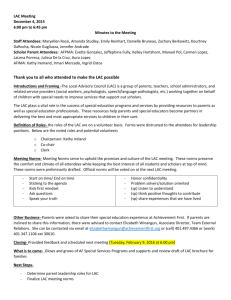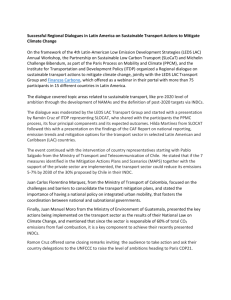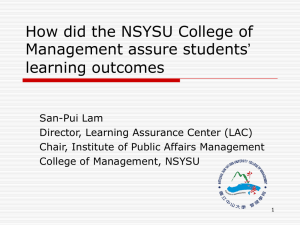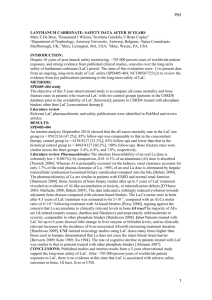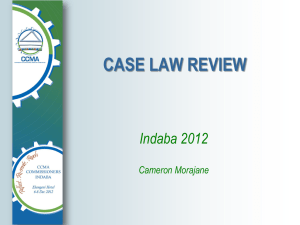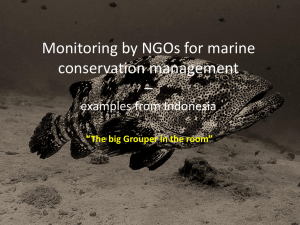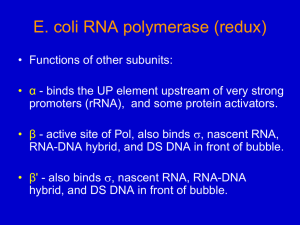Arza Innovation in informal settings
advertisement
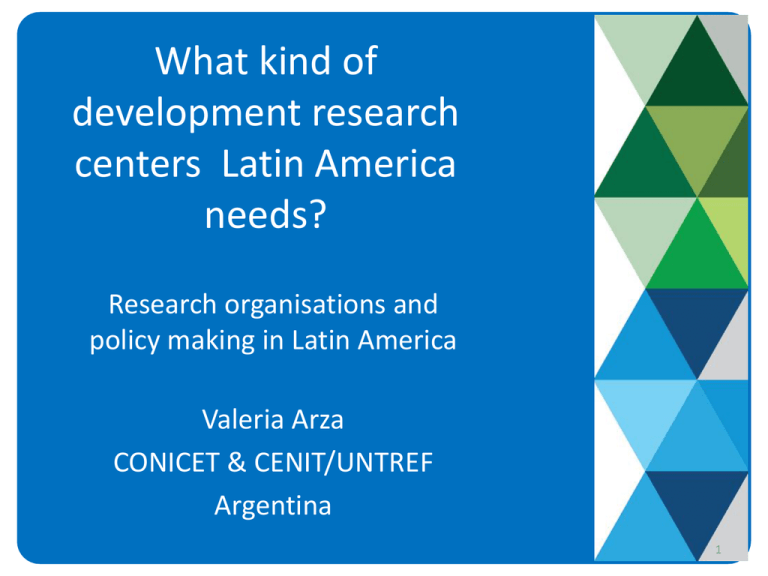
What kind of development research centers Latin America needs? Research organisations and policy making in Latin America Valeria Arza CONICET & CENIT/UNTREF Argentina 1 Introduction In Latin American countries (LAC): • Complex developmental challenges • Good quality research, also in social sciences But No close collaboration between research organisations (RO) and LAC policy making 2 FOCUS Social science. Emphasis on development related research at RO in LAC KEY QUESTIONS What are the guiding principles of the research agenda at RO? Are their research outputs diffused widely? What are the relations between RO and policy makers? Is it possible to improve the social and policy relevance of research carried out in RO? 3 ORGANISATION 1. Characteristics of RO in LAC 2. Relation between RO and policy making 3. Ideas to improve social relevance of research at RO 4 1. Characteristics of RO in LAC 5 1. Characteristic of RO in LAC Historical perspective • Early 20th century: universities; 1950s public research institutes (PRI) – – • UNI: autonomous, responds to scientific system. PRI better aligned to policy Since 1980s, new missions and new RO emerge, contribute to heterogeneity: – – – New public RO aligned to new economic paradigm (e.g. 27 new PRO created in Mexico) Hybrid public-private RO, especially in science NGOs 6 1. Characteristic of RO in LAC Heterogeneity % of RO producing research articles International organisations % of RO enabling online access to research articles 100% 81% Public bodies (gov agencies and PRO) 76% 47% Universities 96% 30% NGO 92% 52% Own elaboration, based on Villatoro, 2005. Sample of 256 organisation in 26 LAC LAC social organisations network (RISALIC) See http://www.risalc.org/portal/instituciones/ Few efforts in knowledge dissemination • 32% of RO have most of their publications online • In Central America 20% in Mercosur 47% 7 1. Characteristic of RO in LAC Heterogeneity Two main groups of RO: one is well integrated to international community and the other more locally oriented. The former: – The most prestigious and well funded. – Its research agenda guided by career progress and is articulated to research interests of the international community. – No incentives to identify or to study developmental needs – No incentives to diffuse findings locally – It reproduces: get funding, train students, publish, gain prestige, etc. 8 1. Characteristic of RO in LAC Funding • Until 1980s, mainly state funds, since then more sources, domestic and, mainly, international • Agenda subordinated to international priorities? • Conflict of interests, when operation budgets are dependent on few sources – Health research in Mexico and tobacco funders of a private RO – Social research for a new mining law and mining funding of a public RO in Argentina 9 2. The relation between RO and policy makers 10 2. RO and Policy Makers How could RO help in policy making? – To understand causal links – To design specific policies – To diffuse and disseminate and thus to enhance wider understanding that helps to gain public consensus for specific policies 11 2. RO and Policy Makers Obstacles • Tactical obstacles: recommendations might lie outside the acceptability area of the electoral base. • Temporal obstacles: urgent needs may not articulate with the scientific culture • Communicational obstacles • Epistemic obstacles: the need to simplify realities to proceed to decision-making does not articulate easily with the complexity of social research. 12 2. RO and Policy Makers Some contexts improve communication • Mutual trust: few number of RO normally achieve it – Negative consequences for democracy and participation. – Risk of political capture by “elite specialist” • Unsettled situations widen range of RO that get access to policy community – Complexity – Policy makers need to validate decisions to the electorate • Political cycles make politicians more or less receptive to RO – Quality research may find policy relevance in a near future • Social research on immigration in the 1990s (based on human rights approach) clashed with political values at the time but found their way in policy making in the mid-2000s in Argentina 13 3. How to improve social relevance of research at RO 14 3. To improve RO relevance Challenges • To identify developmental and social needs • To produce research that responds effectively to those needs without reducing excellence. • To improve public policy quality and to challenge mainstream visions through alternative and longterm thinking based on empirical evidence. • To bridge the cultural and political gap between the community of researchers and that of politicians to make research outputs recognised as valuable inputs for policy making (i.e. to improve applicability of RO research outputs). 15 3. To improve RO relevance Ideas for debate 1. RO internal definitions: To promote internal discussions at RO to define values, strategies and methodologies to improve social relevance and political applicability of social research. – When development and social problems required alternative solutions and analysis, multi and trans-disciplinarity can strengthen RO capacities to do so. 16 3. To improve RO relevance Ideas for debate 2. Interactions: To improve the interaction between RO and civil society to better understand social needs and to make research outputs more visible and thus politically desirable. – This implies direct interaction with civil society groups but also higher efforts in capacity building, dissemination and outreach activities. 17 3. To improve RO relevance Ideas for debate 3. Play politically: Rational/comprehensive models find limits when getting in the policy arena. Policy choices remain highly political – Seek political mediation by social movements or mass media – To become more institutionalised within the political community. 18 Thank you! 19
